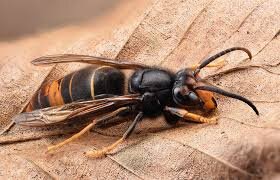
Anglesey Beekeepers are often contacted about swarming insects
But we can only help when the problem involves Honey Bees
Further information can be found here from BeeCraft (www.bee-craft.com)
Bumblebees
Bumblebees are often confused with honeybees. However they are rounder, larger and furrier and come with a variety of coloured stripes across the end of their tails. They often nest in bird boxes, under the decking, or in the compost.
Recommendations: Leave them alone if possible. Bumblebees are an important pollinator and rarely sting and are under threat of extinction.
Beekeepers will not collect/remove Bumblebees
Solitary bees
Are there lots of small bees popping in and out of the wall or very small holes in the ground. Do they have a reddy/brown bottom? Or are they almost black? These are Solitary Bees.
Recommendations: Leave them alone if possible. They are harmless and as their name suggest live more or less alone. They aren't interested in you and should be left alone.
Beekeepers will not collect/remove Solitary Bees
Wasps
Is it very smooth mainly yellow with black stripes? Is it in the roof of your house? Are they coming from a round paper nest? Is there a nest in the shed or in a hole in the ground? Do they have a high pitched buzz? Are they after all things sweet? Then these are probably Wasps.
Recommendations: For more information go to BWARS. Contact your local council pest control.
Beekeepers will not collect/remove Wasps
European Hornet
Are they very big with a loud buzz? Are they black and brown with a hint of orange? Living in the roof or shed? Do they have a very big curved tail? These are Hornets.
Recommendations: For more information go to BWARS. Contact your local council pest control.
Beekeepers will not collect/remove Hornets
Yellow-legged (Asian) Hornet
Dark brown or velvet body with yellow tipped legs? Single yellow stripe on abdomen. Smaller than the European Hornet and usually nests high in trees or man-made structures. Currently in the south east of the UK but no confirmed sightings in Wales at the moment but are a concern as they predate on Honey Bees!
Recommendations: If you do spot one (yellow tipped legs are the key identifier) then please contact alert_nonnative@ceh.ac.uk
Honey Bees
Honeybees are small and vary in colour from golden brown to almost black. If you suspect they have nested in the structure of the building e.g unused chimney behind a soffit board, then click here as there is probably nothing we can do.
If the swarm is in your garden or has not yet entered the structure of your building, then a swarm catcher may be able to recover it.
Please contact the ABKA Secretary on 07449 021219 or 01286 675833 who will provide advice and if appropriate contact a swarm collector on your behalf.
Alternatively, use the Swarm Map below to identify a local beekeeper who collects swarms in your local area.
Swarm map
Click here to access the local beekeepers who collect swarms in your area





